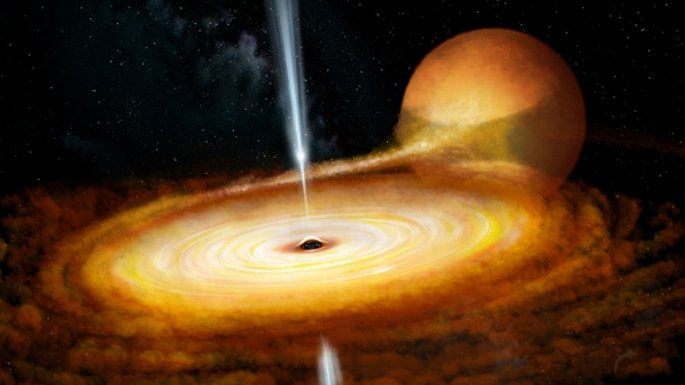The black hole in the Milky Way flashes fiercely when 'eating' a star
A black hole in our own Milky Way is "gobbling up" the star next to it and this event produces rays that astronomers can observe.
The black hole, called MAXI J1820 + 070, is located 10,000 light-years away and is 7 times heavier than the Sun (the lowest estimated mass of a black hole would be 5 times heavier than the Sun).

Pictures simulating black holes MAXI J1820 + 070 are "gobbling up" a star.(Image: John Paice)
Interestingly, the scientists captured the star's flickering light using the new high-frame rate rotation technology, which recorded more than 300 frames per second. Specifically, this data was obtained by the HiPERCAM instrument on the Gran Telescopio Canarias and NASA's NICER X-ray observatory on the International Space Station (ISS).
The researchers then even reproduced this phenomenon in a video using the most modern simulation software.
"The video was made using real data but reduced the motion by only one tenth of the actual motion. This allows the fastest moving light rays to be observed as well. "The naked eye , " explains astronomer John Paice from the University of Southampton and the Center for Astronomy and Astrophysics.
When MAXI consumes a star near it, this black hole will emit not only visible X-rays but also visible light radiation.
The matter around this black hole is unbelievably bright, with the light emitted hundreds of times brighter than the Sun. That also led scientists to think that this could be a sign of the unifying characteristic of black holes like this - black holes help us explain the plasma created and maintained in How is space in space.
- Capture the image of a black hole "choking" when swallowing a star
- The star's painful death was ripped apart by a supermassive black hole
- The star flies more than 1,000 km / sec after 'hiding' from the black hole
- Incidentally the star forms near a black hole
- New findings help prove the theory of black holes
- The 'lonely star' was kicked out of the Milky Way, forever in nothingness
- Catching a super rare scene in the universe: Super giant black hole is swallowing up a star
- The endless dance between the Milky Way
- The mystery of the star escapes the largest black hole in the Milky Way
- Monster black holes are 100,000 times bigger than the Sun.
- Discover the mystery of the most exotic black holes in the universe
- The first time a black hole was discovered, it swallowed a star
- The painful death of a star ripped apart by a supermassive black hole
- The center of the Milky Way may contain thousands of black holes
 Van Allen's belt and evidence that the Apollo 11 mission to the Moon was myth
Van Allen's belt and evidence that the Apollo 11 mission to the Moon was myth The levels of civilization in the universe (Kardashev scale)
The levels of civilization in the universe (Kardashev scale) Today Mars, the sun and the Earth are aligned
Today Mars, the sun and the Earth are aligned The Amazon owner announced a secret plan to build a space base for thousands of people
The Amazon owner announced a secret plan to build a space base for thousands of people